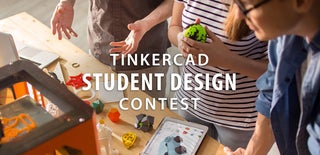Introduction: 3D Printable 2wd RC Car (make It Move)
For this design contest, I decided to try and design an RC Car that could be (almost) fully 3D printable. This is a 1/18 scale 2wd RC car with independent suspension. All parts of this project were designed and modeled in Tinkercad.
Step 1: Designing the Chassis and Suspension Arms
The first thing that I made in this project was the chassis and suspension arms. By doing this, I could get a reference for what sizes the other parts should be in this project. The basic measurements like the chassis length and width as well as the length of the suspension arms were from one of my 1/18 scale RC cars, the Wltoys A969. The shape of the parts were then just eyeballed from pictures of other RC cars on the internet. There is a slight 20 degree kick-up at the front of the chassis so that the front suspension can absorb bumps more easily. I then modeled the hinge pin braces to hold the suspension arms in. All of the screw holes were made after all of the parts were modeled.
Step 2: Making the Steering Components
To make the car less mechanically complex, I decided to use a sliding rack instead of bell-cranks to push the steering links. That is why there is a small channel in the chassis to hold the steering rack. There is one more small link that connects the rack to the steering servo. While making the steering parts, I also made the camber links and steering links.
Step 3: Making the Rear Suspension Arms and Drivetrain
The rear suspension arms were copied from the front of the car with a change to the shock mounting position. The camber links are also the same as the front. The drive-train consists of a solid 'differential' that uses dogbones to transfer power to the wheels instead of universal driveshafts. This makes it more durable and robust when 3d printed. I also used a cross design instead of hexes for the wheel hexes so that it would be more durable.
Step 4: Shock Towers and Shocks
I had planned to use some other shocks that I had lying around on this project, but I felt that it would be a fun challenge to design some. The shocks that I designed consist of 2 parts, though they are grouped as one. The parts are the top cap, and the body with springs and a piston. The body, piston, and spring is all one part. The front shock tower directly screws onto the chassis, and the rear shock tower also includes the case or cover for the transmission so that there are fewer parts.
Step 5: Making the Transmission
This was the part that took the longest when making this project. Designing the gears wasn't too difficult with Tinkercad, but aligning them to the correct position was very difficult. All of the gears are designed with 2mm holes. The spur gear and second small transmission gear have a groove that can hold a rod in the axles to deliver the power between them. I'm not sure if this transmission is brushless-ready, but it should be able to run smoothly with a brushed motor.
Step 6: Making the Wheels and Putting Everything Together in Tinkercad
This RC car has wheels that I made in Tinkercad and the front wheels take bearings for a smoother running car. The measurements for these wheels were taken from my 1/18 scale RC car, the Wltoys A969. Finally, I could put everything together in Tinkercad for a finished product. I wasn't able to perfectly align all of the parts, but I think that the idea is there.
Step 7: Conclusion
I had lots of fun making this project and I learned many things while creating it. This is not the final version and I plan to make further changes to improve it. I hope that this inspired you to go make something of your own. Thank you for sticking around and reading all about my project!

Participated in the
Tinkercad Student Design Contest







